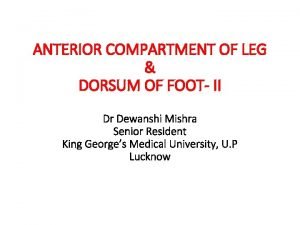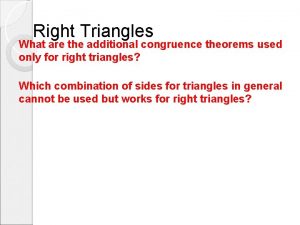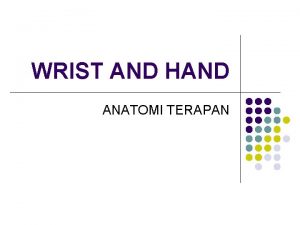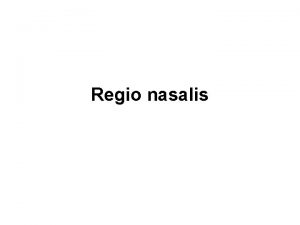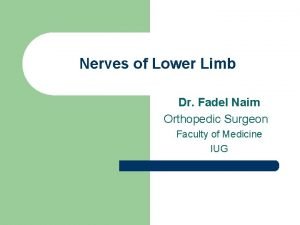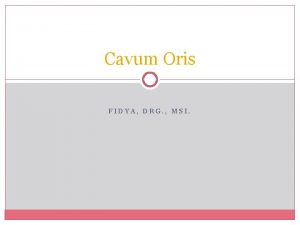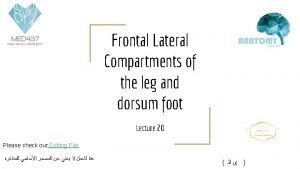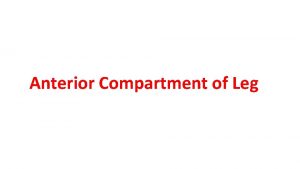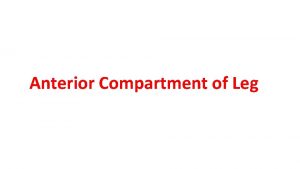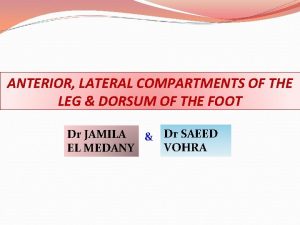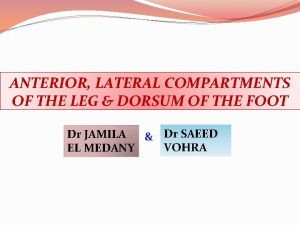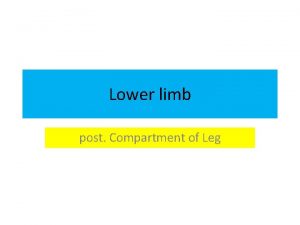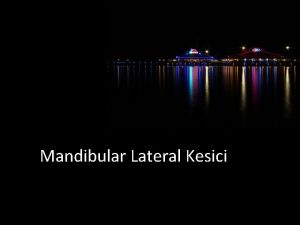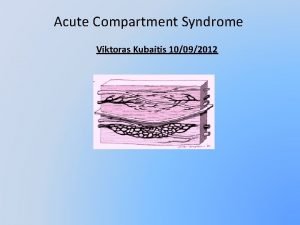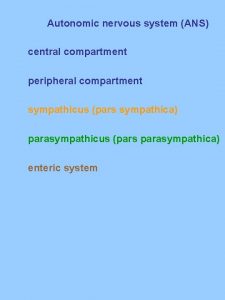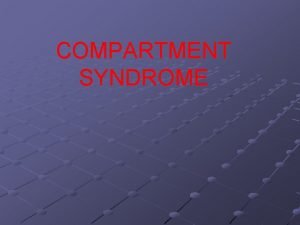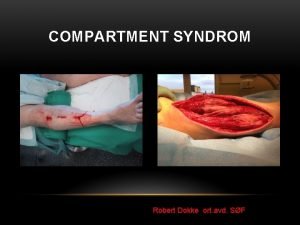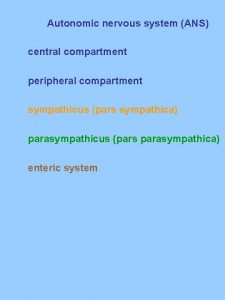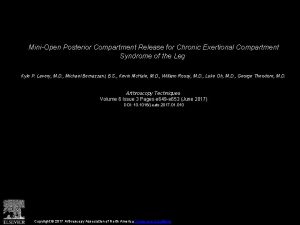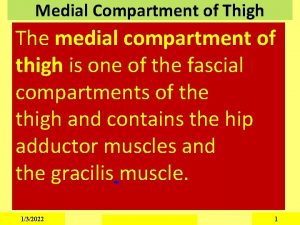Frontal Lateral compartment of Leg and Dorsum of


















- Slides: 18

Frontal, Lateral compartment of Leg and Dorsum of Foot Editing File Color Code Important Doctors Notes/Extra explanation

Objectives üIdentify the deep fascia of leg üIdentify the fascial compartments of the leg üDescribe the anatomy of the anterior & lateral compartments üList the contents of each compartment (muscles, vessels & nerves) üDescribe the anatomy and contents of the dorsum of the foot

Fascia of the Leg • The deep fascia surrounds the leg and is attached to Anterior & Medial borders of Tibia. • Two Intermuscular Septa Pass from the deep aspect of this fascia to be attached to : Anterior border of fibula (Anterior intermuscular septum) Posterior border of fibula (Posterior intermuscular septum) • Interosseous membrane: A thin & strong membrane, that binds the interosseous borders of tibia & fibula. It binds the two bones and provides attachment for muscles. The interosseus membrane and the two intermuscular septa divide the leg into (3) Compartments : 1. Anterior 2. Lateral (peroneal) 3. Posterior Each one has its own Muscles (with specific action), Blood vessels and Nerves.

Anterior Compartment Criteria (Contents) Muscles : • All muscles take origin from the fibula EXCEPT Tibialis Anterior. Nerve supply: • Deep Peroneal. Blood Supply: • Anterior tibial. Action: Dorsiflexion of the ankle joint & Extension of the toes & (Inversion).

Anterior Compartment Muscles Tibialis Anterior Extensor Digitorum Longus Extensor Hallucius* Longus Peroneus Tertius** *Hallucius = big toe **Fibularis Tertius = Pernous tertius

Recall the bones and joints of the foot

Anterior Compartment Muscles

Anterior Compartment Muscles Plantar flexion = flexion of ankle/foot Dorsi flexion = extension of ankle/foot Muscle Origin Insertion Action Tibialis anterior. Lateral surface of shaft of tibia & interosseous membrane. Medial cuneiform & base of 1 st metatarsal bone. Extends foot at ankle joint. Inverts foot at subtalar & transverse tarsal joints. Holds up medial longitudinal arch of foot. Extensor Digitorum Longus. Anterior surface of shaft of fibula. Extensor expansion of lateral four toes. Extends toes. Dorsi flex foot at ankle joint. Peroneus tertius. Anterior surface of shaft of fibula. Base of 5 th metatarsal bone. Dorsi flex foot at ankle joint. Everts foot at subtalar and transverse tarsal joints. Extensor hallucis longus. Anterior surface of shaft of fibula. Base of distal phalanx of great toe. Extends big toe. Dorsi flex foot at ankle joint. Inverts foot at subtalar and transverse tarsal joints.

Extensor Retinaculum A thickening of deep fascia that keep the long tendons around ankle joints in position. Superior Extensor Retinaculum: Attached to anterior surface of tibia and fibula above the ankle. (above the lateral and medial malleolus) Inferior Extensor Retinaculum: Y-shaped and located inferior to ankle.

Structures Passing Deep to Extensor Retinaculum: From medial to lateral : Tom Has a Very Nice Dog & Pigeon 1 - Tibialis anterior 2 - Extensor hallucis longus 3 - Dorsalis pedis artery (vessel) 4 - Dorsalis pedis nerve (nerve) 5 - Extensor digitorum longus 6 - Peroneus tertius

Lateral Compartment: Muscles Muscle Origin Peroneus Longus Peroneus Brevis Lateral surface of shaft of fibula The lateral compartment contains only 2 muscles. The general action is Plantar flexion and Eversion Insertion Action Base of first metatarsal and the medial cuneiform (same as tibialis anterior) 1. Plantar flexes foot at ankle joint 2. Everts foot at subtalar and transverse tarsal joints 3. Supports lateral longitudinal and transverse arches Base of fifth metatarsal bone. (same as peroneus tertius) NOTE: Peroneus = Fibularis 1. Plantar flexes foot at ankle joint; 2. Everts foot at subtalar and transverse tarsal joint 3. Supports Lateral longitudinal arch of foot. Nerve Blood Supply Superficial Peroneal (Musculoc utaneous) Peroneal Artery

Peroneal retinacula 1 -Superior peroneal retinaculum Connects the lateral malleolus to calcaneum & holds the tendons of peroneus longus & brevis 2 -Inferior peroneal retinaculum Synovial Sheaths of Peroneal Longus & Brevis: Above the inferoir peroneal retinaculum tendons of peronei are surrounded by a single common tubular synovial sheath , deep to inferior peroneal retinaculum, they have separate sheaths

Dorsum of foot Deep Fascia of Dorsum of Foot Contents Muscles: Blood Vessel: Nerves: Muscle Extensor Digitorum Brevis Dorsalis Pedis DEEP & Superficial Peroneal It is very thin, but just distal to ankle joint, it is thickened to form Inferior extensor retinaculum. Origin Insertion Innervation Action Anterior part of upper surface of the Calcaneum & from the Inferior extensor retinaculum tendons into the proximal phalanx of the big toe (extensor hallucis brevis) and long extensor tendons to second, third, and fourth toes Deep fibular nerve Extension of toes The muscle has 4 tendons (since it is called digitorum): one on the big toe and 3 on the 2 nd 3 rd and 4 th toes. We call the part that inserts into the big toe extensor hallucis longus, but they are all collectively known as extensor digitorum brevis

Insertion of Long Extensor Tendons (Extensor Expansion) The tendons of Extensor digitorum longus pass to the lateral four toes. - Each tendon to the 2 nd , 3 rd & 4 th toes is joined on its lateral side by a tendon of Extensor digitorum brevis. - The extensor tendons form: a Fascial Expansion (Extensor Expansion) on the dorsum of each toe. -The expansion divides into (3) parts: ~Central part: inserted into the Base of Middle phalangese. ~Two Lateral parts: inserted into the Base of Distal phalangese. The (Extensor Expansion) receives insertion of : Interossei & Lumbrical muscles.

Synovial Sheaths of Extensor Tendons on the Dorsum of Foot Tibialis anterior & Extensor hallucis longus Both have their own synovial sheath Extensor digitorum longus & Peroneus tertius have a common sheath, it extends to the level of Base of 5 th Metatarsal bone.

Summary The interosseus membrane and the two intermuscular septa divide the leg into Anterior Compartment Muscles Tibialis Anterior Extensor Digitorum Longus Extensor Hallucius Longus Peroneus Tertius (all take origin from fibula EXCEPT tibialis anterior) Genreal Action Dorsiflexion of the ankle joint & Extension of the toes & (Inversion). Innervation Deep peroneal Lateral (Peroneal) Compartment Muscles Peroneus longus Peroneus brevis General Action Plantar flexion and Eversion Innervation Superficial peroneal Posterior Compartment Structures Passing Deep to Extensor Retinaculum: From medial to lateral : Tom Has a Very Nice Dog & Pigeon 1 - Tibialis anterior 2 - Extensor hallucis longus 3 - Dorsalis pedis artery (vessel) 4 - Dorsalis pedis nerve 5 - Extensor digitorum longus 6 - Peroneus tertius Contents of dorsum of foot Muscles: Extensor Digitorum Brevis Blood Vessel: Dorsalis Pedis Nerves: Deep & Superficial Peroneal

Questions 1 - Which muscle can evert the foot? A-Tibialis Anterior. B- Extensor Digitorum Longus. C- Peroneus Tertius. D- Extensor Hallucis Longus. 2 - The Peroneus tertius is inserting from anterior surface of fibula to : A- Extensor expansion of lateral four toes. B- Base of distal phalanx of great toe. C- Base of 5 th metatarsal bone. D- Medial cuneiform & base of 1 st metatarsal bone. 3 - The interosseus membrane and the two intermuscular septa divide the leg into ____ compartments. A- 1 B- 2 C- 3 D- 4 4 - Peroneus tertius is the most medial muscle passing down the extensor retinaculum. A- True B- False 5 - The peroneus longus is inserted into: A- Base of first metatarsal B- The medial cuneiform C- The lateral cuneiform D- Both a&b 6 - The blood vessel that supplies the dorsum of foot is the dorsialis pedis A-true B-false 7 - The Extensor Expansion receives insertion of: A- Interossei B- Lumbricals C- Tibialis anterior D- A & B 1 - C 2 - C 3 - C 4 - B 5 - D 6 - A 7 - D

Leaders: Nawaf Al. Khudairy Jawaher Abanumy Ghada Almazrou anatomyteam 436@gmail. com @anatomy 436 Members: Deena Al. Nowiser Lama Al. Tamimi Norah Alshabib Razan Al. Qahtani Thikrayat Omar Wejdan Alzaid
 Gastrocnemius muscle origin and insertion
Gastrocnemius muscle origin and insertion Dorsum of ankle
Dorsum of ankle Freshers syndrome anatomy
Freshers syndrome anatomy Perimysium
Perimysium Hl congruency
Hl congruency Vista superior
Vista superior Leg cradle to lateral lunge
Leg cradle to lateral lunge Gluteal tuberosity
Gluteal tuberosity Regio wrist joint
Regio wrist joint Dorsum planum
Dorsum planum Radix nasi
Radix nasi Innervation of leg
Innervation of leg Schéma tympan
Schéma tympan Dorsum lidah adalah
Dorsum lidah adalah Body medical term
Body medical term Jazyk chutove pohariky
Jazyk chutove pohariky Skull with wings
Skull with wings Kifoza
Kifoza Nose anatomy notes
Nose anatomy notes


